Marks & Spencer's: Business Environment and Stakeholder Analysis
VerifiedAdded on 2023/06/10
|12
|3617
|419
Report
AI Summary
This report provides a comprehensive analysis of the business environment surrounding Marks & Spencer's, a prominent British multinational retailer. It delves into various aspects, starting with an overview of the company's background, legal structure (Public Limited Company), and its position within an oligopoly market structure. The report identifies and analyzes key stakeholders, including shareholders, and employs a stakeholder analysis process to prioritize their involvement. Furthermore, it utilizes PESTLE analysis to evaluate the political, economic, social, technological, legal, and environmental factors influencing the business. The report also highlights the importance of Porter's Five Forces model in assessing competitive strength and profitability within the industry, examining factors such as the bargaining power of customers and suppliers. Desklib offers a wide range of solved assignments and study tools for students.

Understanding the business environment
Paraphrase This Document
Need a fresh take? Get an instant paraphrase of this document with our AI Paraphraser
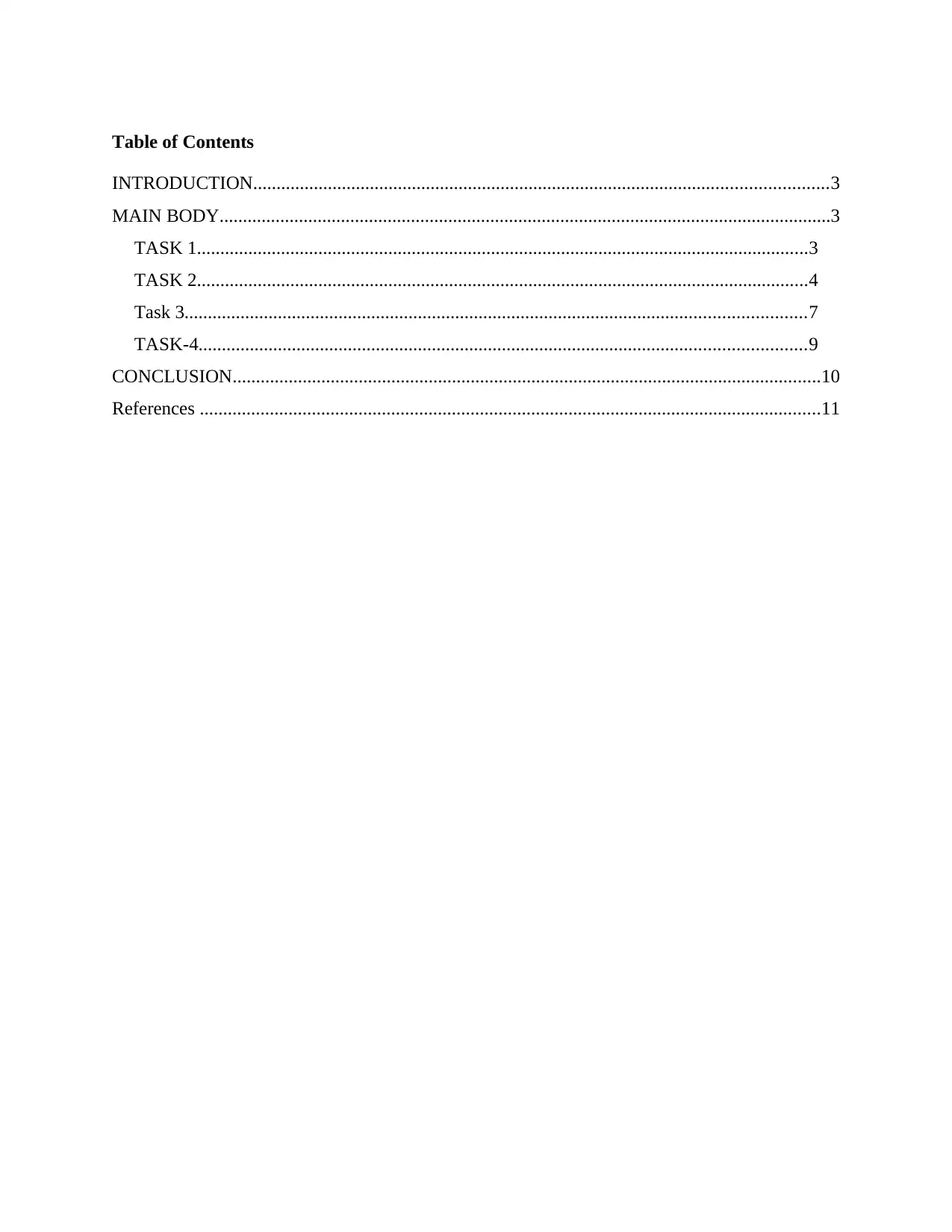
Table of Contents
INTRODUCTION...........................................................................................................................3
MAIN BODY...................................................................................................................................3
TASK 1...................................................................................................................................3
TASK 2...................................................................................................................................4
Task 3.....................................................................................................................................7
TASK-4..................................................................................................................................9
CONCLUSION..............................................................................................................................10
References .....................................................................................................................................11
INTRODUCTION...........................................................................................................................3
MAIN BODY...................................................................................................................................3
TASK 1...................................................................................................................................3
TASK 2...................................................................................................................................4
Task 3.....................................................................................................................................7
TASK-4..................................................................................................................................9
CONCLUSION..............................................................................................................................10
References .....................................................................................................................................11
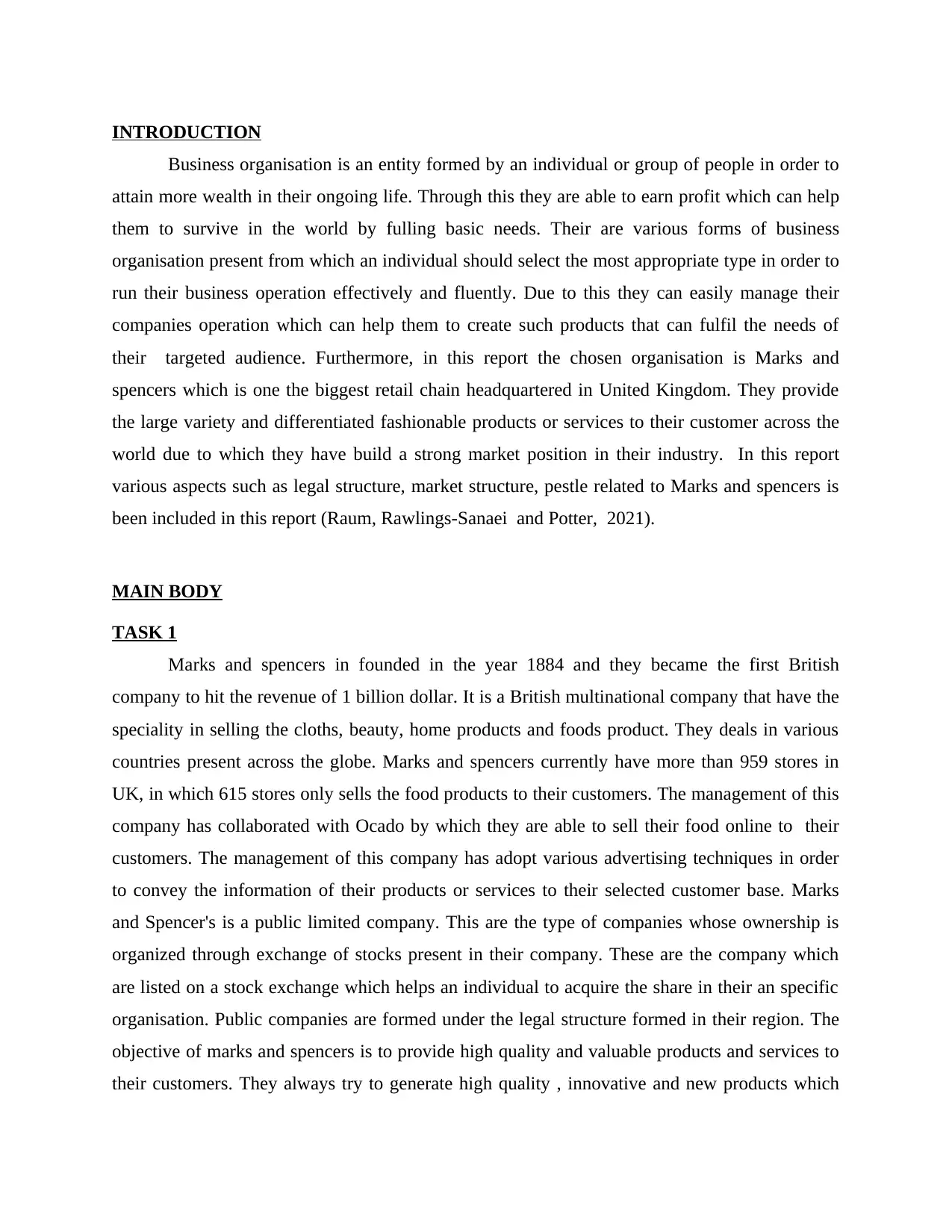
INTRODUCTION
Business organisation is an entity formed by an individual or group of people in order to
attain more wealth in their ongoing life. Through this they are able to earn profit which can help
them to survive in the world by fulling basic needs. Their are various forms of business
organisation present from which an individual should select the most appropriate type in order to
run their business operation effectively and fluently. Due to this they can easily manage their
companies operation which can help them to create such products that can fulfil the needs of
their targeted audience. Furthermore, in this report the chosen organisation is Marks and
spencers which is one the biggest retail chain headquartered in United Kingdom. They provide
the large variety and differentiated fashionable products or services to their customer across the
world due to which they have build a strong market position in their industry. In this report
various aspects such as legal structure, market structure, pestle related to Marks and spencers is
been included in this report (Raum, Rawlings-Sanaei and Potter, 2021).
MAIN BODY
TASK 1
Marks and spencers in founded in the year 1884 and they became the first British
company to hit the revenue of 1 billion dollar. It is a British multinational company that have the
speciality in selling the cloths, beauty, home products and foods product. They deals in various
countries present across the globe. Marks and spencers currently have more than 959 stores in
UK, in which 615 stores only sells the food products to their customers. The management of this
company has collaborated with Ocado by which they are able to sell their food online to their
customers. The management of this company has adopt various advertising techniques in order
to convey the information of their products or services to their selected customer base. Marks
and Spencer's is a public limited company. This are the type of companies whose ownership is
organized through exchange of stocks present in their company. These are the company which
are listed on a stock exchange which helps an individual to acquire the share in their an specific
organisation. Public companies are formed under the legal structure formed in their region. The
objective of marks and spencers is to provide high quality and valuable products and services to
their customers. They always try to generate high quality , innovative and new products which
Business organisation is an entity formed by an individual or group of people in order to
attain more wealth in their ongoing life. Through this they are able to earn profit which can help
them to survive in the world by fulling basic needs. Their are various forms of business
organisation present from which an individual should select the most appropriate type in order to
run their business operation effectively and fluently. Due to this they can easily manage their
companies operation which can help them to create such products that can fulfil the needs of
their targeted audience. Furthermore, in this report the chosen organisation is Marks and
spencers which is one the biggest retail chain headquartered in United Kingdom. They provide
the large variety and differentiated fashionable products or services to their customer across the
world due to which they have build a strong market position in their industry. In this report
various aspects such as legal structure, market structure, pestle related to Marks and spencers is
been included in this report (Raum, Rawlings-Sanaei and Potter, 2021).
MAIN BODY
TASK 1
Marks and spencers in founded in the year 1884 and they became the first British
company to hit the revenue of 1 billion dollar. It is a British multinational company that have the
speciality in selling the cloths, beauty, home products and foods product. They deals in various
countries present across the globe. Marks and spencers currently have more than 959 stores in
UK, in which 615 stores only sells the food products to their customers. The management of this
company has collaborated with Ocado by which they are able to sell their food online to their
customers. The management of this company has adopt various advertising techniques in order
to convey the information of their products or services to their selected customer base. Marks
and Spencer's is a public limited company. This are the type of companies whose ownership is
organized through exchange of stocks present in their company. These are the company which
are listed on a stock exchange which helps an individual to acquire the share in their an specific
organisation. Public companies are formed under the legal structure formed in their region. The
objective of marks and spencers is to provide high quality and valuable products and services to
their customers. They always try to generate high quality , innovative and new products which
⊘ This is a preview!⊘
Do you want full access?
Subscribe today to unlock all pages.

Trusted by 1+ million students worldwide
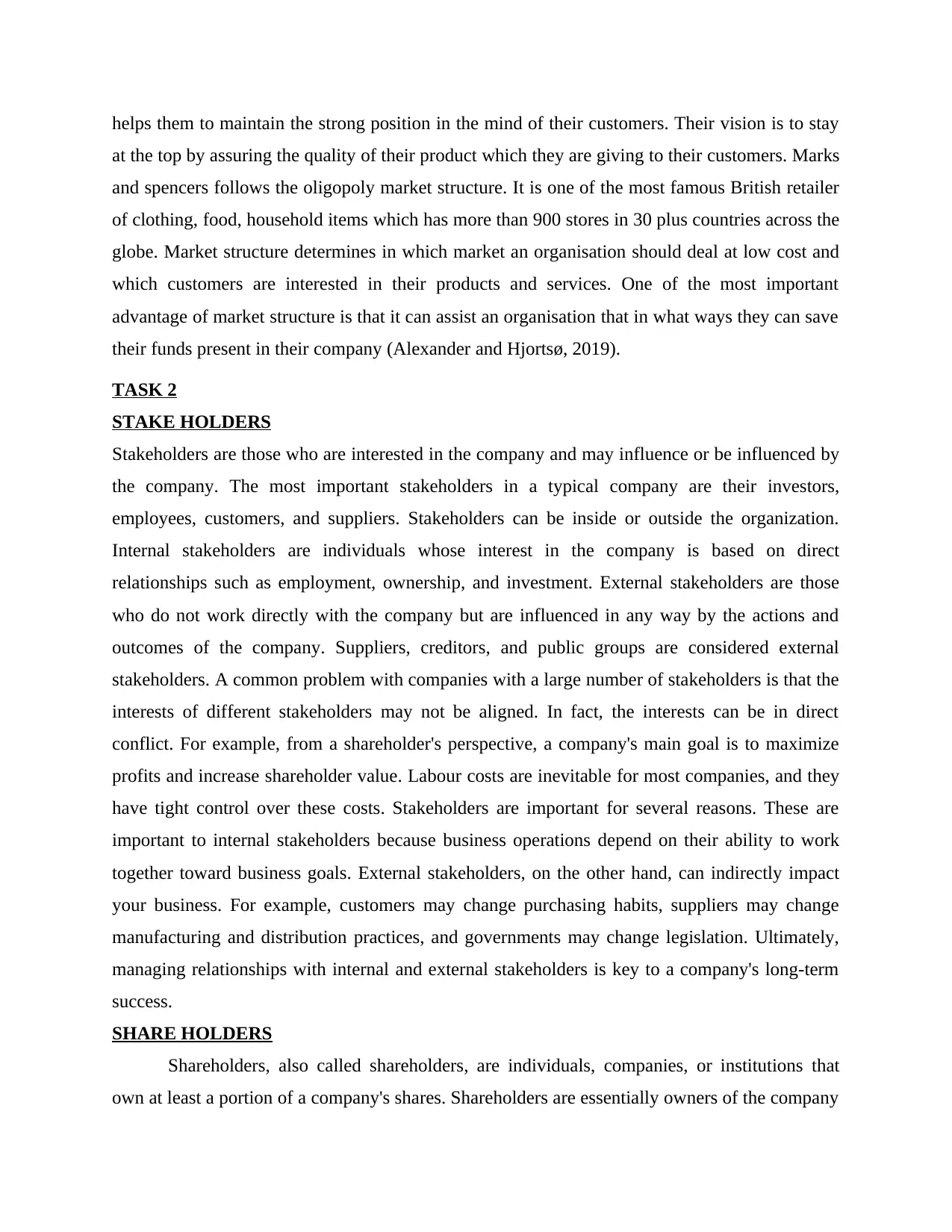
helps them to maintain the strong position in the mind of their customers. Their vision is to stay
at the top by assuring the quality of their product which they are giving to their customers. Marks
and spencers follows the oligopoly market structure. It is one of the most famous British retailer
of clothing, food, household items which has more than 900 stores in 30 plus countries across the
globe. Market structure determines in which market an organisation should deal at low cost and
which customers are interested in their products and services. One of the most important
advantage of market structure is that it can assist an organisation that in what ways they can save
their funds present in their company (Alexander and Hjortsø, 2019).
TASK 2
STAKE HOLDERS
Stakeholders are those who are interested in the company and may influence or be influenced by
the company. The most important stakeholders in a typical company are their investors,
employees, customers, and suppliers. Stakeholders can be inside or outside the organization.
Internal stakeholders are individuals whose interest in the company is based on direct
relationships such as employment, ownership, and investment. External stakeholders are those
who do not work directly with the company but are influenced in any way by the actions and
outcomes of the company. Suppliers, creditors, and public groups are considered external
stakeholders. A common problem with companies with a large number of stakeholders is that the
interests of different stakeholders may not be aligned. In fact, the interests can be in direct
conflict. For example, from a shareholder's perspective, a company's main goal is to maximize
profits and increase shareholder value. Labour costs are inevitable for most companies, and they
have tight control over these costs. Stakeholders are important for several reasons. These are
important to internal stakeholders because business operations depend on their ability to work
together toward business goals. External stakeholders, on the other hand, can indirectly impact
your business. For example, customers may change purchasing habits, suppliers may change
manufacturing and distribution practices, and governments may change legislation. Ultimately,
managing relationships with internal and external stakeholders is key to a company's long-term
success.
SHARE HOLDERS
Shareholders, also called shareholders, are individuals, companies, or institutions that
own at least a portion of a company's shares. Shareholders are essentially owners of the company
at the top by assuring the quality of their product which they are giving to their customers. Marks
and spencers follows the oligopoly market structure. It is one of the most famous British retailer
of clothing, food, household items which has more than 900 stores in 30 plus countries across the
globe. Market structure determines in which market an organisation should deal at low cost and
which customers are interested in their products and services. One of the most important
advantage of market structure is that it can assist an organisation that in what ways they can save
their funds present in their company (Alexander and Hjortsø, 2019).
TASK 2
STAKE HOLDERS
Stakeholders are those who are interested in the company and may influence or be influenced by
the company. The most important stakeholders in a typical company are their investors,
employees, customers, and suppliers. Stakeholders can be inside or outside the organization.
Internal stakeholders are individuals whose interest in the company is based on direct
relationships such as employment, ownership, and investment. External stakeholders are those
who do not work directly with the company but are influenced in any way by the actions and
outcomes of the company. Suppliers, creditors, and public groups are considered external
stakeholders. A common problem with companies with a large number of stakeholders is that the
interests of different stakeholders may not be aligned. In fact, the interests can be in direct
conflict. For example, from a shareholder's perspective, a company's main goal is to maximize
profits and increase shareholder value. Labour costs are inevitable for most companies, and they
have tight control over these costs. Stakeholders are important for several reasons. These are
important to internal stakeholders because business operations depend on their ability to work
together toward business goals. External stakeholders, on the other hand, can indirectly impact
your business. For example, customers may change purchasing habits, suppliers may change
manufacturing and distribution practices, and governments may change legislation. Ultimately,
managing relationships with internal and external stakeholders is key to a company's long-term
success.
SHARE HOLDERS
Shareholders, also called shareholders, are individuals, companies, or institutions that
own at least a portion of a company's shares. Shareholders are essentially owners of the company
Paraphrase This Document
Need a fresh take? Get an instant paraphrase of this document with our AI Paraphraser

and therefore benefit from the success of the company. These rewards are offered in the form of
monetary gains paid as higher stock valuations or dividends. After that, the shareholders are
divided into two parts:-
Common shareholders- A common shareholder is a person who owns the common stock of a
company. They are the most common type of shareholder and have voting rights on issues that
affect the company. Because they control how the company operates, they have the right to file a
class action proceeding against the company for any misconduct that could harm the
organization.
Preferred shareholders- On the other hand, it is rare. Unlike ordinary shareholders, they own
some of the company's preferred stock and do not have voting rights or a voice in the company's
management. (Eskerod, and Larsen, 2018)
STAKE HORLDER ANALYSIS.
It is a systematic framework that helps an organization to identify, examine and prioritize
the entities that are directly affected by the business operations conducted by an organization.
Not everyone involved needs the same attention. Careful analysis helps organizations identify
stakeholders who support and oppose the project, how strongly they feel about the project, and
how much they can influence the outcome. This valuable information helps organizations make
decisions. Who and how much an organisation need to work with in the course of the project? By
concentrating efforts in this way, organizations do not waste time and resources unnecessarily. A
thorough stakeholder assessment helps organizations determine which types of communication
and messages are most successful. This allows organizations to minimize negative perceptions,
amplify positive impacts, and resolve conflicts before they escalate. Knowledge also helps the
management of company better to adjust their daily commitment to get the results an
organisation want.
STAKEHOLDER ANALYSIS PROCESS
Identify Stakeholders
The first phase of stakeholder involvement investigates potential third parties and
organizations. There may be different groups that are directly influenced by the Marks &
Spencer Management Initiative, have influence or power over their success, and are involved in
successful or unsuccessful completion. (Franco-Trigo and et.al., 2020).
monetary gains paid as higher stock valuations or dividends. After that, the shareholders are
divided into two parts:-
Common shareholders- A common shareholder is a person who owns the common stock of a
company. They are the most common type of shareholder and have voting rights on issues that
affect the company. Because they control how the company operates, they have the right to file a
class action proceeding against the company for any misconduct that could harm the
organization.
Preferred shareholders- On the other hand, it is rare. Unlike ordinary shareholders, they own
some of the company's preferred stock and do not have voting rights or a voice in the company's
management. (Eskerod, and Larsen, 2018)
STAKE HORLDER ANALYSIS.
It is a systematic framework that helps an organization to identify, examine and prioritize
the entities that are directly affected by the business operations conducted by an organization.
Not everyone involved needs the same attention. Careful analysis helps organizations identify
stakeholders who support and oppose the project, how strongly they feel about the project, and
how much they can influence the outcome. This valuable information helps organizations make
decisions. Who and how much an organisation need to work with in the course of the project? By
concentrating efforts in this way, organizations do not waste time and resources unnecessarily. A
thorough stakeholder assessment helps organizations determine which types of communication
and messages are most successful. This allows organizations to minimize negative perceptions,
amplify positive impacts, and resolve conflicts before they escalate. Knowledge also helps the
management of company better to adjust their daily commitment to get the results an
organisation want.
STAKEHOLDER ANALYSIS PROCESS
Identify Stakeholders
The first phase of stakeholder involvement investigates potential third parties and
organizations. There may be different groups that are directly influenced by the Marks &
Spencer Management Initiative, have influence or power over their success, and are involved in
successful or unsuccessful completion. (Franco-Trigo and et.al., 2020).
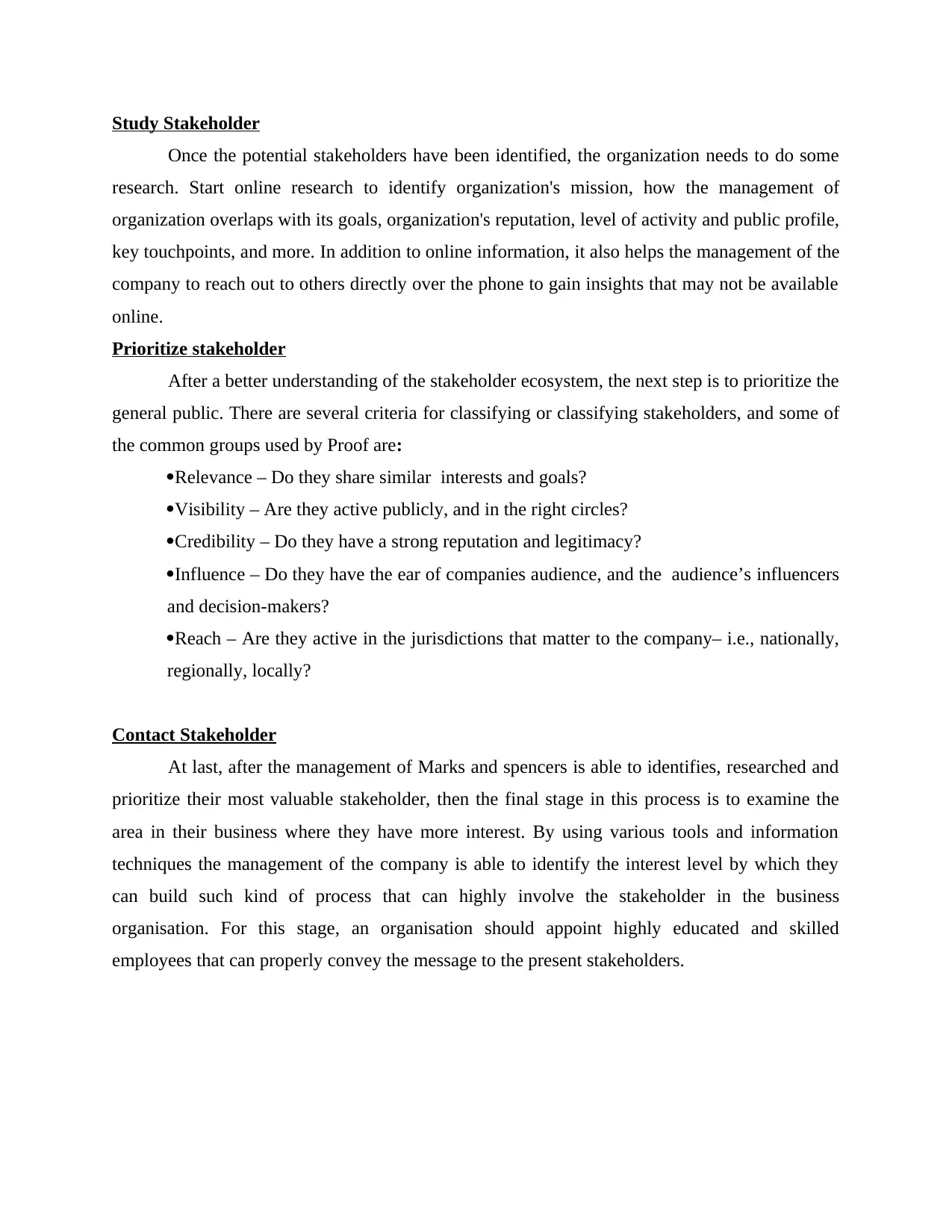
Study Stakeholder
Once the potential stakeholders have been identified, the organization needs to do some
research. Start online research to identify organization's mission, how the management of
organization overlaps with its goals, organization's reputation, level of activity and public profile,
key touchpoints, and more. In addition to online information, it also helps the management of the
company to reach out to others directly over the phone to gain insights that may not be available
online.
Prioritize stakeholder
After a better understanding of the stakeholder ecosystem, the next step is to prioritize the
general public. There are several criteria for classifying or classifying stakeholders, and some of
the common groups used by Proof are:
Relevance – Do they share similar interests and goals?
Visibility – Are they active publicly, and in the right circles?
Credibility – Do they have a strong reputation and legitimacy?
Influence – Do they have the ear of companies audience, and the audience’s influencers
and decision-makers?
Reach – Are they active in the jurisdictions that matter to the company– i.e., nationally,
regionally, locally?
Contact Stakeholder
At last, after the management of Marks and spencers is able to identifies, researched and
prioritize their most valuable stakeholder, then the final stage in this process is to examine the
area in their business where they have more interest. By using various tools and information
techniques the management of the company is able to identify the interest level by which they
can build such kind of process that can highly involve the stakeholder in the business
organisation. For this stage, an organisation should appoint highly educated and skilled
employees that can properly convey the message to the present stakeholders.
Once the potential stakeholders have been identified, the organization needs to do some
research. Start online research to identify organization's mission, how the management of
organization overlaps with its goals, organization's reputation, level of activity and public profile,
key touchpoints, and more. In addition to online information, it also helps the management of the
company to reach out to others directly over the phone to gain insights that may not be available
online.
Prioritize stakeholder
After a better understanding of the stakeholder ecosystem, the next step is to prioritize the
general public. There are several criteria for classifying or classifying stakeholders, and some of
the common groups used by Proof are:
Relevance – Do they share similar interests and goals?
Visibility – Are they active publicly, and in the right circles?
Credibility – Do they have a strong reputation and legitimacy?
Influence – Do they have the ear of companies audience, and the audience’s influencers
and decision-makers?
Reach – Are they active in the jurisdictions that matter to the company– i.e., nationally,
regionally, locally?
Contact Stakeholder
At last, after the management of Marks and spencers is able to identifies, researched and
prioritize their most valuable stakeholder, then the final stage in this process is to examine the
area in their business where they have more interest. By using various tools and information
techniques the management of the company is able to identify the interest level by which they
can build such kind of process that can highly involve the stakeholder in the business
organisation. For this stage, an organisation should appoint highly educated and skilled
employees that can properly convey the message to the present stakeholders.
⊘ This is a preview!⊘
Do you want full access?
Subscribe today to unlock all pages.

Trusted by 1+ million students worldwide
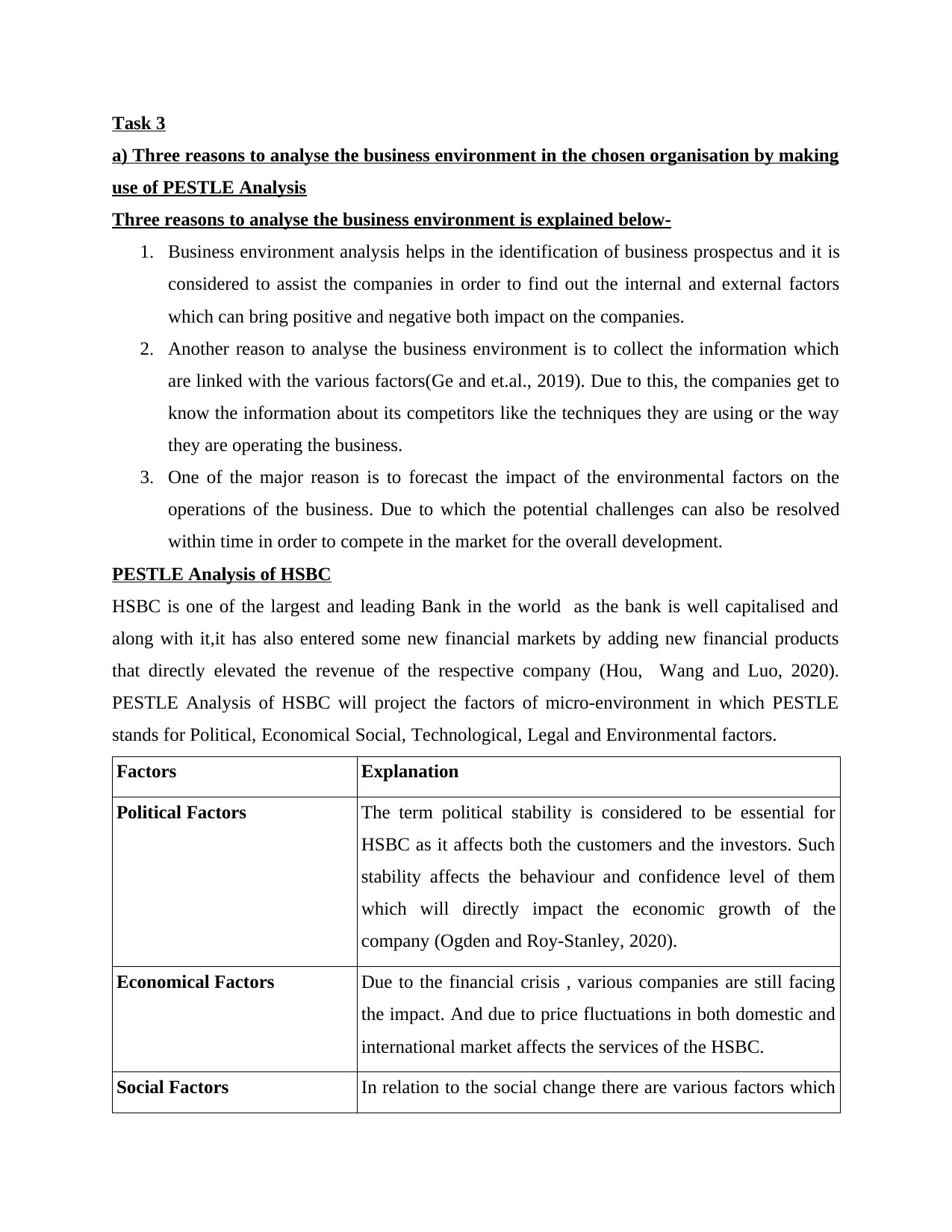
Task 3
a) Three reasons to analyse the business environment in the chosen organisation by making
use of PESTLE Analysis
Three reasons to analyse the business environment is explained below-
1. Business environment analysis helps in the identification of business prospectus and it is
considered to assist the companies in order to find out the internal and external factors
which can bring positive and negative both impact on the companies.
2. Another reason to analyse the business environment is to collect the information which
are linked with the various factors(Ge and et.al., 2019). Due to this, the companies get to
know the information about its competitors like the techniques they are using or the way
they are operating the business.
3. One of the major reason is to forecast the impact of the environmental factors on the
operations of the business. Due to which the potential challenges can also be resolved
within time in order to compete in the market for the overall development.
PESTLE Analysis of HSBC
HSBC is one of the largest and leading Bank in the world as the bank is well capitalised and
along with it,it has also entered some new financial markets by adding new financial products
that directly elevated the revenue of the respective company (Hou, Wang and Luo, 2020).
PESTLE Analysis of HSBC will project the factors of micro-environment in which PESTLE
stands for Political, Economical Social, Technological, Legal and Environmental factors.
Factors Explanation
Political Factors The term political stability is considered to be essential for
HSBC as it affects both the customers and the investors. Such
stability affects the behaviour and confidence level of them
which will directly impact the economic growth of the
company (Ogden and Roy-Stanley, 2020).
Economical Factors Due to the financial crisis , various companies are still facing
the impact. And due to price fluctuations in both domestic and
international market affects the services of the HSBC.
Social Factors In relation to the social change there are various factors which
a) Three reasons to analyse the business environment in the chosen organisation by making
use of PESTLE Analysis
Three reasons to analyse the business environment is explained below-
1. Business environment analysis helps in the identification of business prospectus and it is
considered to assist the companies in order to find out the internal and external factors
which can bring positive and negative both impact on the companies.
2. Another reason to analyse the business environment is to collect the information which
are linked with the various factors(Ge and et.al., 2019). Due to this, the companies get to
know the information about its competitors like the techniques they are using or the way
they are operating the business.
3. One of the major reason is to forecast the impact of the environmental factors on the
operations of the business. Due to which the potential challenges can also be resolved
within time in order to compete in the market for the overall development.
PESTLE Analysis of HSBC
HSBC is one of the largest and leading Bank in the world as the bank is well capitalised and
along with it,it has also entered some new financial markets by adding new financial products
that directly elevated the revenue of the respective company (Hou, Wang and Luo, 2020).
PESTLE Analysis of HSBC will project the factors of micro-environment in which PESTLE
stands for Political, Economical Social, Technological, Legal and Environmental factors.
Factors Explanation
Political Factors The term political stability is considered to be essential for
HSBC as it affects both the customers and the investors. Such
stability affects the behaviour and confidence level of them
which will directly impact the economic growth of the
company (Ogden and Roy-Stanley, 2020).
Economical Factors Due to the financial crisis , various companies are still facing
the impact. And due to price fluctuations in both domestic and
international market affects the services of the HSBC.
Social Factors In relation to the social change there are various factors which
Paraphrase This Document
Need a fresh take? Get an instant paraphrase of this document with our AI Paraphraser
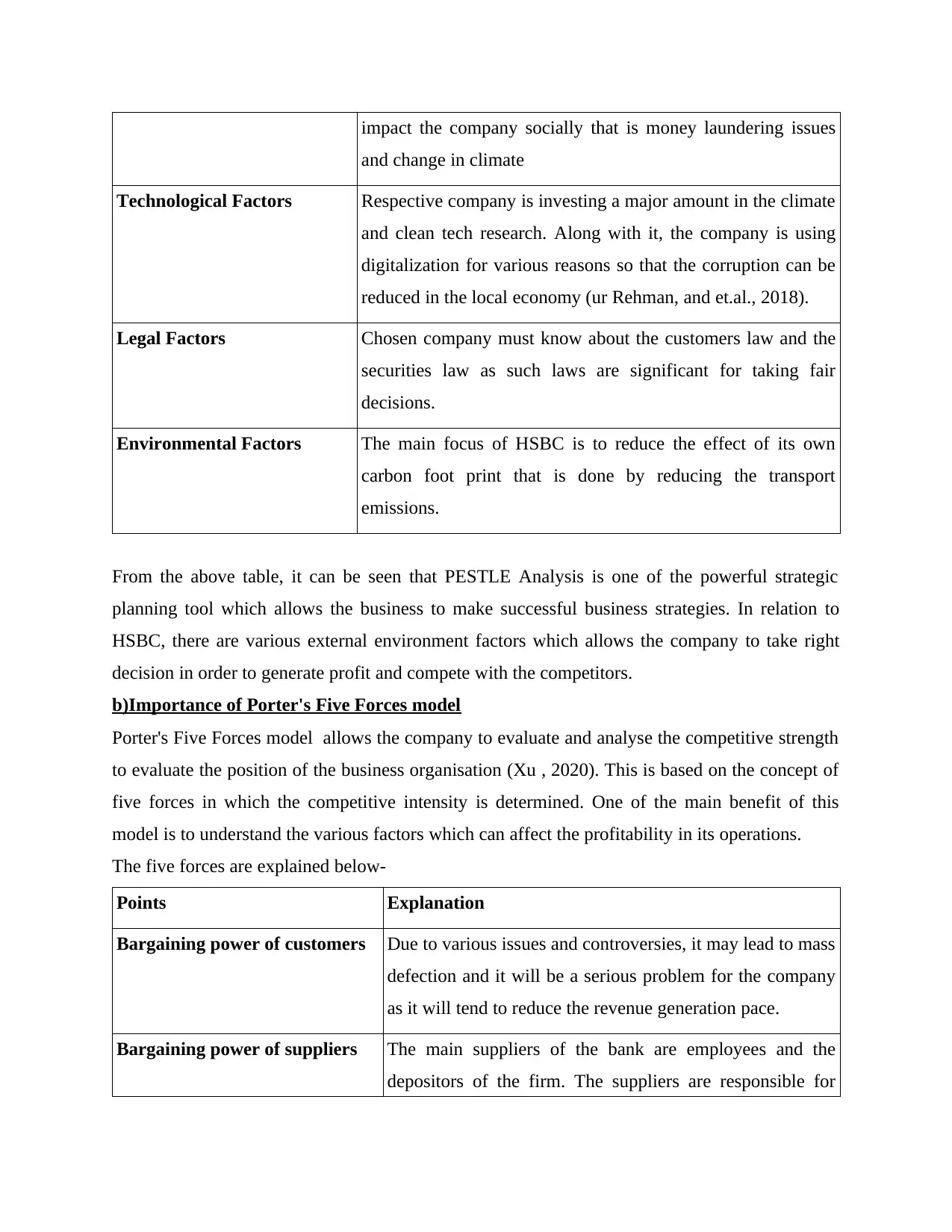
impact the company socially that is money laundering issues
and change in climate
Technological Factors Respective company is investing a major amount in the climate
and clean tech research. Along with it, the company is using
digitalization for various reasons so that the corruption can be
reduced in the local economy (ur Rehman, and et.al., 2018).
Legal Factors Chosen company must know about the customers law and the
securities law as such laws are significant for taking fair
decisions.
Environmental Factors The main focus of HSBC is to reduce the effect of its own
carbon foot print that is done by reducing the transport
emissions.
From the above table, it can be seen that PESTLE Analysis is one of the powerful strategic
planning tool which allows the business to make successful business strategies. In relation to
HSBC, there are various external environment factors which allows the company to take right
decision in order to generate profit and compete with the competitors.
b)Importance of Porter's Five Forces model
Porter's Five Forces model allows the company to evaluate and analyse the competitive strength
to evaluate the position of the business organisation (Xu , 2020). This is based on the concept of
five forces in which the competitive intensity is determined. One of the main benefit of this
model is to understand the various factors which can affect the profitability in its operations.
The five forces are explained below-
Points Explanation
Bargaining power of customers Due to various issues and controversies, it may lead to mass
defection and it will be a serious problem for the company
as it will tend to reduce the revenue generation pace.
Bargaining power of suppliers The main suppliers of the bank are employees and the
depositors of the firm. The suppliers are responsible for
and change in climate
Technological Factors Respective company is investing a major amount in the climate
and clean tech research. Along with it, the company is using
digitalization for various reasons so that the corruption can be
reduced in the local economy (ur Rehman, and et.al., 2018).
Legal Factors Chosen company must know about the customers law and the
securities law as such laws are significant for taking fair
decisions.
Environmental Factors The main focus of HSBC is to reduce the effect of its own
carbon foot print that is done by reducing the transport
emissions.
From the above table, it can be seen that PESTLE Analysis is one of the powerful strategic
planning tool which allows the business to make successful business strategies. In relation to
HSBC, there are various external environment factors which allows the company to take right
decision in order to generate profit and compete with the competitors.
b)Importance of Porter's Five Forces model
Porter's Five Forces model allows the company to evaluate and analyse the competitive strength
to evaluate the position of the business organisation (Xu , 2020). This is based on the concept of
five forces in which the competitive intensity is determined. One of the main benefit of this
model is to understand the various factors which can affect the profitability in its operations.
The five forces are explained below-
Points Explanation
Bargaining power of customers Due to various issues and controversies, it may lead to mass
defection and it will be a serious problem for the company
as it will tend to reduce the revenue generation pace.
Bargaining power of suppliers The main suppliers of the bank are employees and the
depositors of the firm. The suppliers are responsible for
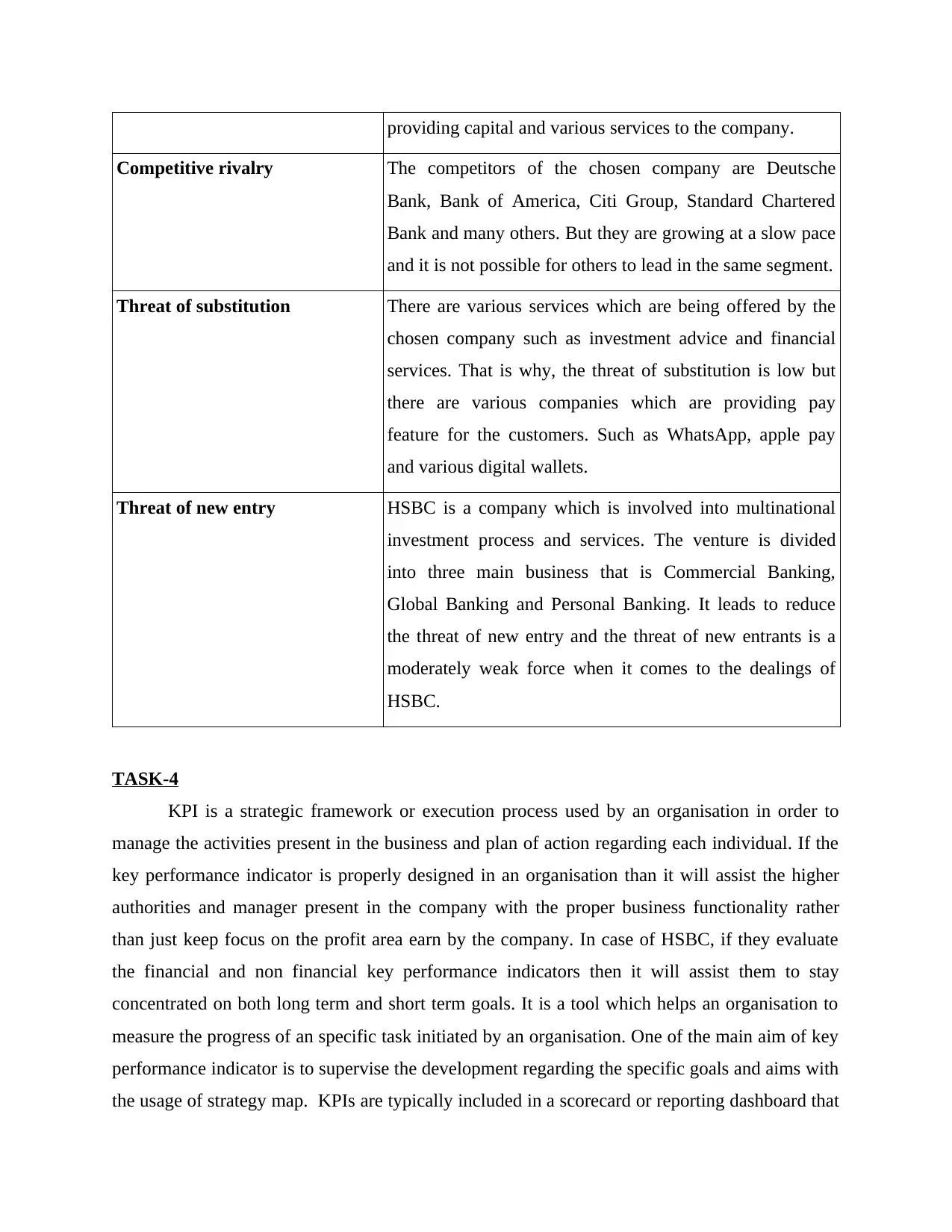
providing capital and various services to the company.
Competitive rivalry The competitors of the chosen company are Deutsche
Bank, Bank of America, Citi Group, Standard Chartered
Bank and many others. But they are growing at a slow pace
and it is not possible for others to lead in the same segment.
Threat of substitution There are various services which are being offered by the
chosen company such as investment advice and financial
services. That is why, the threat of substitution is low but
there are various companies which are providing pay
feature for the customers. Such as WhatsApp, apple pay
and various digital wallets.
Threat of new entry HSBC is a company which is involved into multinational
investment process and services. The venture is divided
into three main business that is Commercial Banking,
Global Banking and Personal Banking. It leads to reduce
the threat of new entry and the threat of new entrants is a
moderately weak force when it comes to the dealings of
HSBC.
TASK-4
KPI is a strategic framework or execution process used by an organisation in order to
manage the activities present in the business and plan of action regarding each individual. If the
key performance indicator is properly designed in an organisation than it will assist the higher
authorities and manager present in the company with the proper business functionality rather
than just keep focus on the profit area earn by the company. In case of HSBC, if they evaluate
the financial and non financial key performance indicators then it will assist them to stay
concentrated on both long term and short term goals. It is a tool which helps an organisation to
measure the progress of an specific task initiated by an organisation. One of the main aim of key
performance indicator is to supervise the development regarding the specific goals and aims with
the usage of strategy map. KPIs are typically included in a scorecard or reporting dashboard that
Competitive rivalry The competitors of the chosen company are Deutsche
Bank, Bank of America, Citi Group, Standard Chartered
Bank and many others. But they are growing at a slow pace
and it is not possible for others to lead in the same segment.
Threat of substitution There are various services which are being offered by the
chosen company such as investment advice and financial
services. That is why, the threat of substitution is low but
there are various companies which are providing pay
feature for the customers. Such as WhatsApp, apple pay
and various digital wallets.
Threat of new entry HSBC is a company which is involved into multinational
investment process and services. The venture is divided
into three main business that is Commercial Banking,
Global Banking and Personal Banking. It leads to reduce
the threat of new entry and the threat of new entrants is a
moderately weak force when it comes to the dealings of
HSBC.
TASK-4
KPI is a strategic framework or execution process used by an organisation in order to
manage the activities present in the business and plan of action regarding each individual. If the
key performance indicator is properly designed in an organisation than it will assist the higher
authorities and manager present in the company with the proper business functionality rather
than just keep focus on the profit area earn by the company. In case of HSBC, if they evaluate
the financial and non financial key performance indicators then it will assist them to stay
concentrated on both long term and short term goals. It is a tool which helps an organisation to
measure the progress of an specific task initiated by an organisation. One of the main aim of key
performance indicator is to supervise the development regarding the specific goals and aims with
the usage of strategy map. KPIs are typically included in a scorecard or reporting dashboard that
⊘ This is a preview!⊘
Do you want full access?
Subscribe today to unlock all pages.

Trusted by 1+ million students worldwide
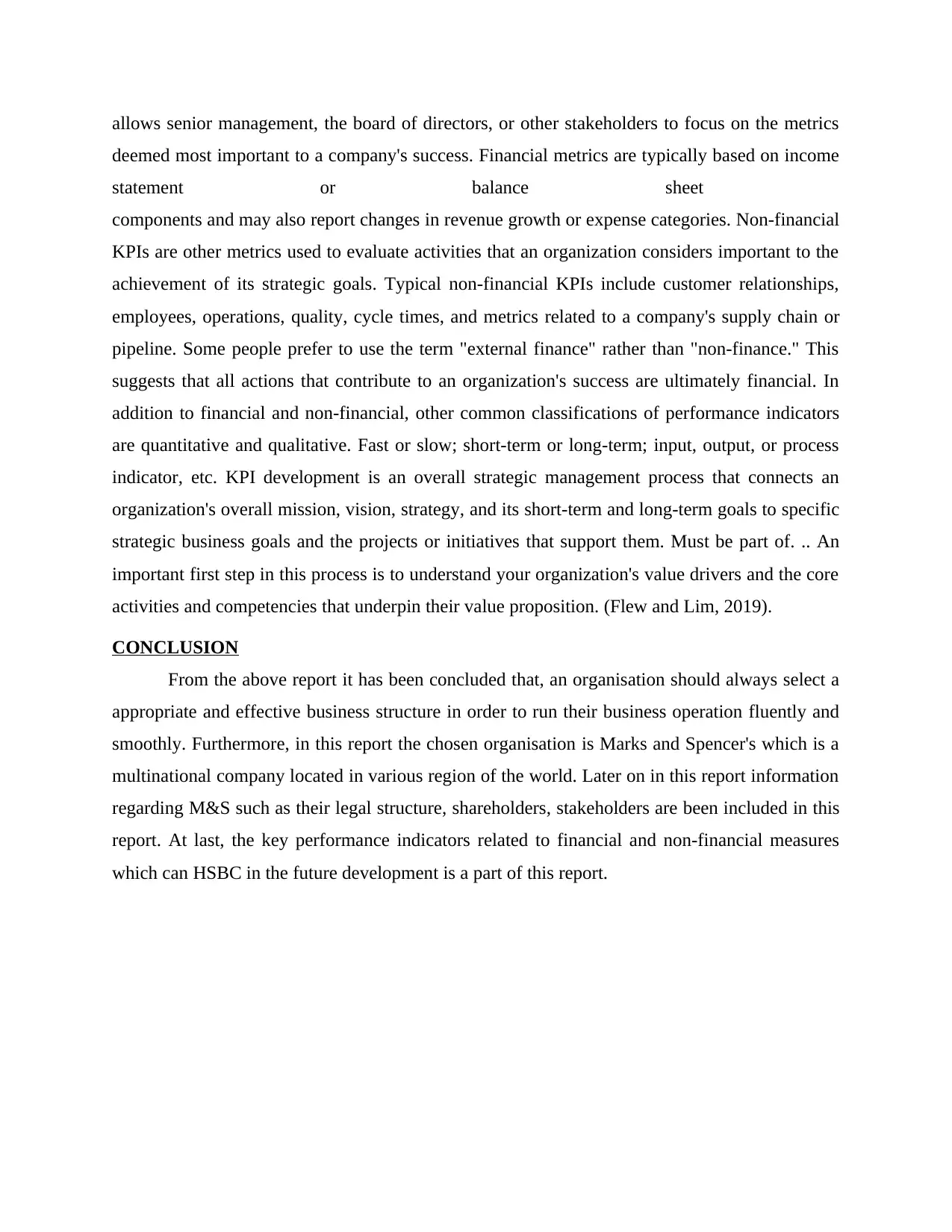
allows senior management, the board of directors, or other stakeholders to focus on the metrics
deemed most important to a company's success. Financial metrics are typically based on income
statement or balance sheet
components and may also report changes in revenue growth or expense categories. Non-financial
KPIs are other metrics used to evaluate activities that an organization considers important to the
achievement of its strategic goals. Typical non-financial KPIs include customer relationships,
employees, operations, quality, cycle times, and metrics related to a company's supply chain or
pipeline. Some people prefer to use the term "external finance" rather than "non-finance." This
suggests that all actions that contribute to an organization's success are ultimately financial. In
addition to financial and non-financial, other common classifications of performance indicators
are quantitative and qualitative. Fast or slow; short-term or long-term; input, output, or process
indicator, etc. KPI development is an overall strategic management process that connects an
organization's overall mission, vision, strategy, and its short-term and long-term goals to specific
strategic business goals and the projects or initiatives that support them. Must be part of. .. An
important first step in this process is to understand your organization's value drivers and the core
activities and competencies that underpin their value proposition. (Flew and Lim, 2019).
CONCLUSION
From the above report it has been concluded that, an organisation should always select a
appropriate and effective business structure in order to run their business operation fluently and
smoothly. Furthermore, in this report the chosen organisation is Marks and Spencer's which is a
multinational company located in various region of the world. Later on in this report information
regarding M&S such as their legal structure, shareholders, stakeholders are been included in this
report. At last, the key performance indicators related to financial and non-financial measures
which can HSBC in the future development is a part of this report.
deemed most important to a company's success. Financial metrics are typically based on income
statement or balance sheet
components and may also report changes in revenue growth or expense categories. Non-financial
KPIs are other metrics used to evaluate activities that an organization considers important to the
achievement of its strategic goals. Typical non-financial KPIs include customer relationships,
employees, operations, quality, cycle times, and metrics related to a company's supply chain or
pipeline. Some people prefer to use the term "external finance" rather than "non-finance." This
suggests that all actions that contribute to an organization's success are ultimately financial. In
addition to financial and non-financial, other common classifications of performance indicators
are quantitative and qualitative. Fast or slow; short-term or long-term; input, output, or process
indicator, etc. KPI development is an overall strategic management process that connects an
organization's overall mission, vision, strategy, and its short-term and long-term goals to specific
strategic business goals and the projects or initiatives that support them. Must be part of. .. An
important first step in this process is to understand your organization's value drivers and the core
activities and competencies that underpin their value proposition. (Flew and Lim, 2019).
CONCLUSION
From the above report it has been concluded that, an organisation should always select a
appropriate and effective business structure in order to run their business operation fluently and
smoothly. Furthermore, in this report the chosen organisation is Marks and Spencer's which is a
multinational company located in various region of the world. Later on in this report information
regarding M&S such as their legal structure, shareholders, stakeholders are been included in this
report. At last, the key performance indicators related to financial and non-financial measures
which can HSBC in the future development is a part of this report.
Paraphrase This Document
Need a fresh take? Get an instant paraphrase of this document with our AI Paraphraser
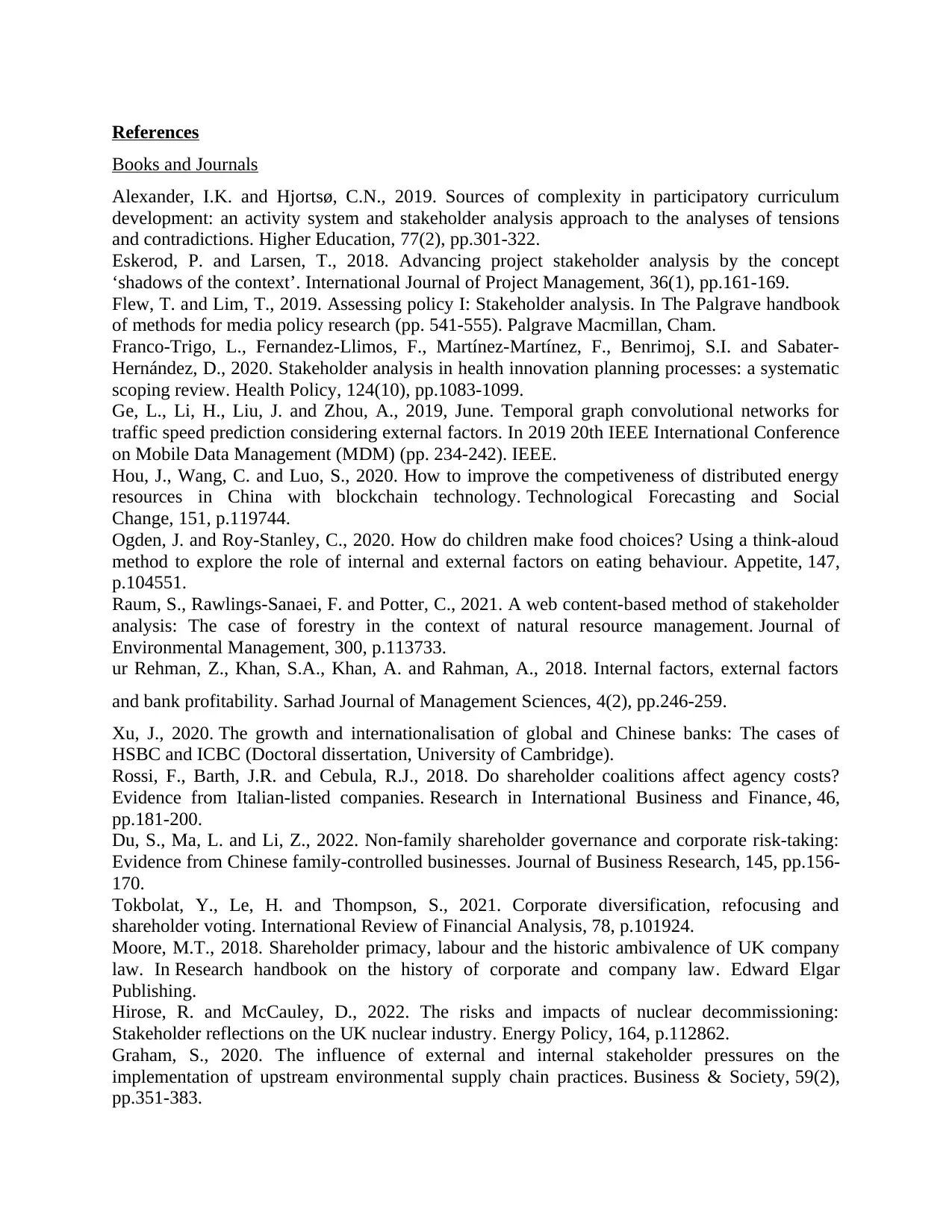
References
Books and Journals
Alexander, I.K. and Hjortsø, C.N., 2019. Sources of complexity in participatory curriculum
development: an activity system and stakeholder analysis approach to the analyses of tensions
and contradictions. Higher Education, 77(2), pp.301-322.
Eskerod, P. and Larsen, T., 2018. Advancing project stakeholder analysis by the concept
‘shadows of the context’. International Journal of Project Management, 36(1), pp.161-169.
Flew, T. and Lim, T., 2019. Assessing policy I: Stakeholder analysis. In The Palgrave handbook
of methods for media policy research (pp. 541-555). Palgrave Macmillan, Cham.
Franco-Trigo, L., Fernandez-Llimos, F., Martínez-Martínez, F., Benrimoj, S.I. and Sabater-
Hernández, D., 2020. Stakeholder analysis in health innovation planning processes: a systematic
scoping review. Health Policy, 124(10), pp.1083-1099.
Ge, L., Li, H., Liu, J. and Zhou, A., 2019, June. Temporal graph convolutional networks for
traffic speed prediction considering external factors. In 2019 20th IEEE International Conference
on Mobile Data Management (MDM) (pp. 234-242). IEEE.
Hou, J., Wang, C. and Luo, S., 2020. How to improve the competiveness of distributed energy
resources in China with blockchain technology. Technological Forecasting and Social
Change, 151, p.119744.
Ogden, J. and Roy-Stanley, C., 2020. How do children make food choices? Using a think-aloud
method to explore the role of internal and external factors on eating behaviour. Appetite, 147,
p.104551.
Raum, S., Rawlings-Sanaei, F. and Potter, C., 2021. A web content-based method of stakeholder
analysis: The case of forestry in the context of natural resource management. Journal of
Environmental Management, 300, p.113733.
ur Rehman, Z., Khan, S.A., Khan, A. and Rahman, A., 2018. Internal factors, external factors
and bank profitability. Sarhad Journal of Management Sciences, 4(2), pp.246-259.
Xu, J., 2020. The growth and internationalisation of global and Chinese banks: The cases of
HSBC and ICBC (Doctoral dissertation, University of Cambridge).
Rossi, F., Barth, J.R. and Cebula, R.J., 2018. Do shareholder coalitions affect agency costs?
Evidence from Italian-listed companies. Research in International Business and Finance, 46,
pp.181-200.
Du, S., Ma, L. and Li, Z., 2022. Non-family shareholder governance and corporate risk-taking:
Evidence from Chinese family-controlled businesses. Journal of Business Research, 145, pp.156-
170.
Tokbolat, Y., Le, H. and Thompson, S., 2021. Corporate diversification, refocusing and
shareholder voting. International Review of Financial Analysis, 78, p.101924.
Moore, M.T., 2018. Shareholder primacy, labour and the historic ambivalence of UK company
law. In Research handbook on the history of corporate and company law. Edward Elgar
Publishing.
Hirose, R. and McCauley, D., 2022. The risks and impacts of nuclear decommissioning:
Stakeholder reflections on the UK nuclear industry. Energy Policy, 164, p.112862.
Graham, S., 2020. The influence of external and internal stakeholder pressures on the
implementation of upstream environmental supply chain practices. Business & Society, 59(2),
pp.351-383.
Books and Journals
Alexander, I.K. and Hjortsø, C.N., 2019. Sources of complexity in participatory curriculum
development: an activity system and stakeholder analysis approach to the analyses of tensions
and contradictions. Higher Education, 77(2), pp.301-322.
Eskerod, P. and Larsen, T., 2018. Advancing project stakeholder analysis by the concept
‘shadows of the context’. International Journal of Project Management, 36(1), pp.161-169.
Flew, T. and Lim, T., 2019. Assessing policy I: Stakeholder analysis. In The Palgrave handbook
of methods for media policy research (pp. 541-555). Palgrave Macmillan, Cham.
Franco-Trigo, L., Fernandez-Llimos, F., Martínez-Martínez, F., Benrimoj, S.I. and Sabater-
Hernández, D., 2020. Stakeholder analysis in health innovation planning processes: a systematic
scoping review. Health Policy, 124(10), pp.1083-1099.
Ge, L., Li, H., Liu, J. and Zhou, A., 2019, June. Temporal graph convolutional networks for
traffic speed prediction considering external factors. In 2019 20th IEEE International Conference
on Mobile Data Management (MDM) (pp. 234-242). IEEE.
Hou, J., Wang, C. and Luo, S., 2020. How to improve the competiveness of distributed energy
resources in China with blockchain technology. Technological Forecasting and Social
Change, 151, p.119744.
Ogden, J. and Roy-Stanley, C., 2020. How do children make food choices? Using a think-aloud
method to explore the role of internal and external factors on eating behaviour. Appetite, 147,
p.104551.
Raum, S., Rawlings-Sanaei, F. and Potter, C., 2021. A web content-based method of stakeholder
analysis: The case of forestry in the context of natural resource management. Journal of
Environmental Management, 300, p.113733.
ur Rehman, Z., Khan, S.A., Khan, A. and Rahman, A., 2018. Internal factors, external factors
and bank profitability. Sarhad Journal of Management Sciences, 4(2), pp.246-259.
Xu, J., 2020. The growth and internationalisation of global and Chinese banks: The cases of
HSBC and ICBC (Doctoral dissertation, University of Cambridge).
Rossi, F., Barth, J.R. and Cebula, R.J., 2018. Do shareholder coalitions affect agency costs?
Evidence from Italian-listed companies. Research in International Business and Finance, 46,
pp.181-200.
Du, S., Ma, L. and Li, Z., 2022. Non-family shareholder governance and corporate risk-taking:
Evidence from Chinese family-controlled businesses. Journal of Business Research, 145, pp.156-
170.
Tokbolat, Y., Le, H. and Thompson, S., 2021. Corporate diversification, refocusing and
shareholder voting. International Review of Financial Analysis, 78, p.101924.
Moore, M.T., 2018. Shareholder primacy, labour and the historic ambivalence of UK company
law. In Research handbook on the history of corporate and company law. Edward Elgar
Publishing.
Hirose, R. and McCauley, D., 2022. The risks and impacts of nuclear decommissioning:
Stakeholder reflections on the UK nuclear industry. Energy Policy, 164, p.112862.
Graham, S., 2020. The influence of external and internal stakeholder pressures on the
implementation of upstream environmental supply chain practices. Business & Society, 59(2),
pp.351-383.

⊘ This is a preview!⊘
Do you want full access?
Subscribe today to unlock all pages.

Trusted by 1+ million students worldwide
1 out of 12
Related Documents
Your All-in-One AI-Powered Toolkit for Academic Success.
+13062052269
info@desklib.com
Available 24*7 on WhatsApp / Email
![[object Object]](/_next/static/media/star-bottom.7253800d.svg)
Unlock your academic potential
Copyright © 2020–2025 A2Z Services. All Rights Reserved. Developed and managed by ZUCOL.





